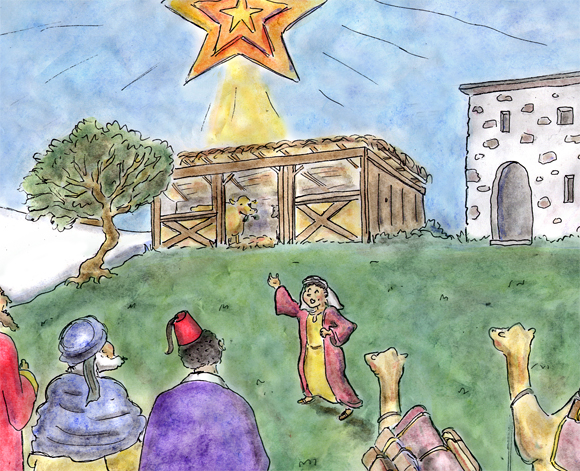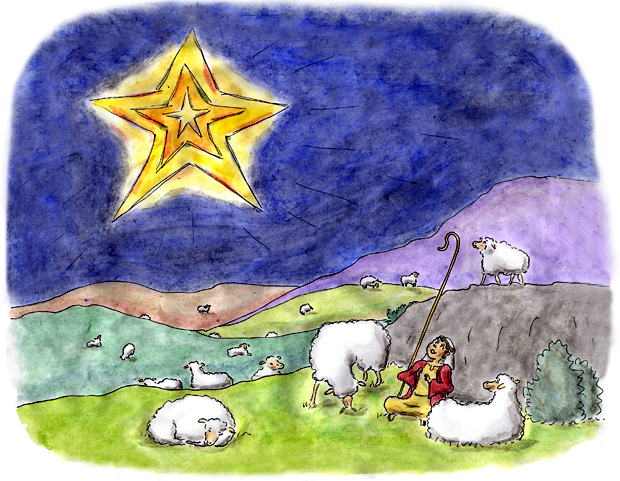Merry 6th Day of Christmas! A week from today, on Jan. 6th, it will be time to celebrate Epiphany, a great way to extend the season with family and friends! Later this week, on Thursday, I'll post some ideas for games and foods and music for Epiphany, but today I'm offering a little background along with some of the legends and traditions associated with the season. You can find more about Epiphany on the website for the book Star of Wonder -- which is where these illustrations are from. (This would be a perfect book to share with children as part of any Epiphany celebration.)
Why Celebrate Epiphany?
The joyful energy of Epiphany has always inspired games and pageants, music and meals. It's a multi-cultural celebration because the Three Kings who followed the star to find the Holy Child came from different cultures and continents. Epiphany comes at the end of the Twelve Days of Christmas—on January 6th. Although American tradition focuses on Christmas Day as the primary day to give and receive gifts, in some southern European and Latin American cultures, Epiphany is actually the accepted time for gift-giving. Instead of expecting Santa Claus to deliver presents on Christmas Eve, children wait for the Three Kings to bring them gifts on Epiphany.
Epiphany comes at the end of the Twelve Days of Christmas—on January 6th. Although American tradition focuses on Christmas Day as the primary day to give and receive gifts, in some southern European and Latin American cultures, Epiphany is actually the accepted time for gift-giving. Instead of expecting Santa Claus to deliver presents on Christmas Eve, children wait for the Three Kings to bring them gifts on Epiphany. When my children were little, I could never finish all my shopping and planning by Christmas Day, so spreading out the celebration between Christmas and Epiphany became a happy solution (besides, it let me take advantage of post-Christmas sales). It also helped refocus Christmas Day on the Holy Birth instead of just the glut of presents.
Epiphany comes after older children are back in school, so it can feel like a special treat to have the holiday season extend into "ordinary time."
And if, by chance, you are separated from your children (or grandchildren) on Christmas itself, you still have the chance to share this very special holiday together.

BACKGROUND ON THE SEASON
Epiphany celebrations throughout the centuries: Epiphany is one of the oldest Christian holidays, celebrated since the second century in the Eastern Church. In its early years, Epiphany was a double celebration honoring both the birth and the baptism of Jesus. The Syrian church maintained a combined festival, seeing the baptism as Jesus' "spiritual birth," and in some places Epiphany is still called "the holiday of the second birth." The Western Church adapted Epiphany to focus on the visit of the Magi, wise men (often called "kings") from afar who were able to interpret the stars. The whole Epiphany season celebrates manifestations of Jesus to the world; seasonal readings in the Western Church begin on January 6, Epiphany Day, with Matthew's account of the visit of the Magi, while the following Sundays in Epiphany include readings about Jesus' baptism by John in the Jordan, his first miracle at the wedding feast in Cana, and the miraculous feeding of 5000.
The Western Church adapted Epiphany to focus on the visit of the Magi, wise men (often called "kings") from afar who were able to interpret the stars. The whole Epiphany season celebrates manifestations of Jesus to the world; seasonal readings in the Western Church begin on January 6, Epiphany Day, with Matthew's account of the visit of the Magi, while the following Sundays in Epiphany include readings about Jesus' baptism by John in the Jordan, his first miracle at the wedding feast in Cana, and the miraculous feeding of 5000. For the shepherd boy Jesse in Star of Wonder, holding the hand of the infant Jesus is his Epiphany, his "aha!" moment of recognizing the Holy Child.
PAGEANTS AND OTHER TRADITIONS OF THE SEASON
Festival of Light

Because of the bright star which led the Magi to the Holy Child, Epiphany also became a festival of light.
This was especially evident in the huge bonfires in the center of each village as everyone brought Christmas trees to be burned on Epiphany Day, singing,
Farewell to thee, O Christmas tree!Remnants of this tradition endure in places that still have a Christmas-tree-burning on Epiphany; when my children were little, they looked forward to "the beautiful fire" at the town dump as part of our Epiphany celebration.
Thy part is done
And thy gifts are gone,
And thy lights are dying one by one.
Good-bye to the tree
Good fortune was said to come to those who kept their Christmas greens until Epiphany. One European tradition connected to this belief was called "Plundering the Tree." On Epiphany, villagers would go from house to house and dance around their neighbors' trees, then eat the last of the Christmas treats. The hostess would have taken the ornaments off the tree and set them in piles around the room, and each guest would choose a pile to take home to use next year; in this way, Christmas decorations circulated among the whole village year by year. At the end of the evening, all the plundered trees were taken to the center of town and burned.
Plays and parties
Although the visit of the Magi on Epiphany was celebrated with a certain solemnity during the Middle Ages, it became an occasion for wanton frivolity during the reign of Queen Elizabeth I—so outrageous, in fact, were the antics presided over by the Lord of Misrule that the Puritans rejected not only Epiphany but Christmas as well because the whole holiday season seemed to have lost religious significance and become an excuse to party. Epiphany was celebrated at court with jesters, jugglers, music, storytelling and plays. In France, the performer who received the most applause was clothed in a scarlet robe and crowned as King, reigning over the evening's festivities. Performances of one sort or another remain part of the Epiphany tradition even into more recent years. "We Three Kings," the well-known Epiphany carol, was actually written as part of a pageant at General Theological Seminary in New York City.
EPIPHANY LEGENDS

The Three Kings on their journey
In Matthew's original account of the Magi, no specific number of wise men is given. Although Syrian tradition says there were twelve wise men, most note only three—based on the three gifts they bring of gold, frankincense, and myrrh—and most traditions name them as kings.Tertullian writes of Epiphany as the "festival of kings." In the "Armenian Childhood Book," an apocryphal writing from the end of the sixth century, the Magi are called three Persian kings, and an angel—not a star—shows the way.
The Venerable Bede, who died in 735, called the Magi "kings" and gave them names: Caspar, Melchior, and Balthasar. He also established their backgrounds as being from the three known continents: Europe, Africa, and Asia.

No comments:
Post a Comment